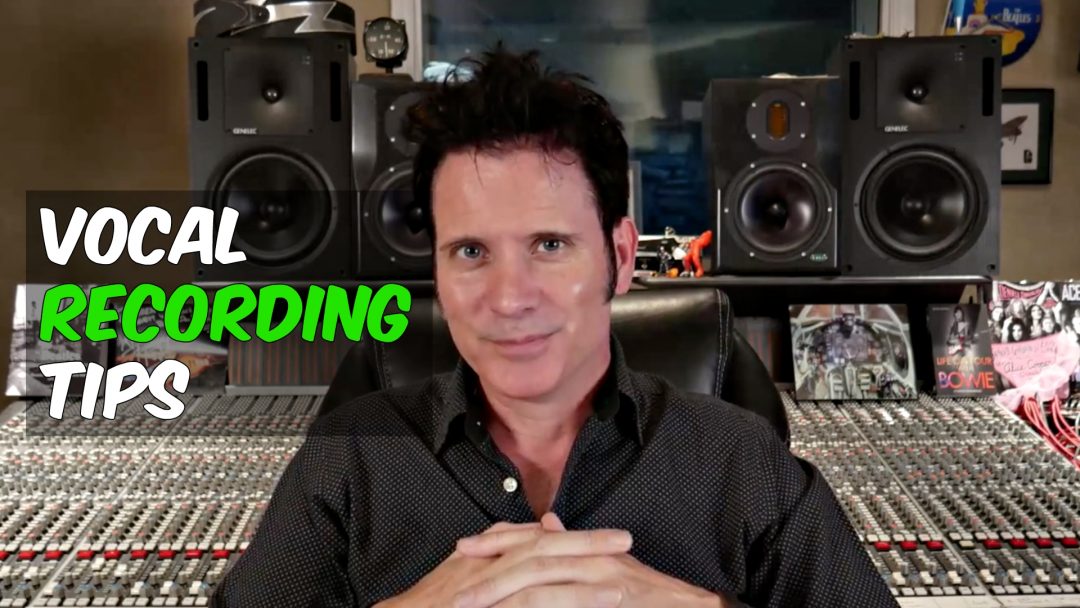Recording a great sounding vocal in the studio sounds like it should be a simple task. You set up a microphone, have your singer to stand in front of it, give them a set of headphones and hit the record button. Although this is the basic set up, there are a few things I’ve learned throughout the years that have helped me get better sounding vocal tracks! A great sounding vocal is the cornerstone of modern rock, pop and country music, so you want to get it right. Here are my 5 tips for recording a great sounding vocal.
1. Give the vocalist a good headphone mix: Make sure the artist has what they need in their headphone mix so that they can perform to the best of their ability. Artists might not be able to communicate their needs so it’s up to you to check their headphone mix and communicate with them. Ask them questions… Do you have your own headphones that you prefer to use? Do you want reverb or delay effects in your headphone mix? If they don’t have their own headphones and you have more than one set, let them try different models out. Some singers may want a brighter sounding headphone, and some might want something with more bottom end. Give them what they need in the headphones so that they can perform comfortably.
2. Make the vocalist comfortable: Read the room and know your artist; what’s good for the singer is good for the band. Pay attention to little things, like what is the temperature in the room, or the lighting in the room. The singer may like the lighting brighter so that they can read their lyrics or darker so they can feel a little more isolated. They might want the band to be there watching them and giving them feedback on their performance. They might want to be alone so they can focus on the emotion of the song and lyric. You can also make them feel comfortable by having everything set up for them before they begin to record. Go out of your way to make a singer feel comfortable by having their favorite drinks, having their mic and headphones already setup, and their lyric sheet on music stand ready and waiting.
3. Mic choice: There are hundreds of microphones to choose from. You might have 2 or 3 (or a dozen) quality microphones at your disposal for recording vocals. If the singer is up for it, do a shootout between some of your mics and find the one that you both think sounds the best.
What do you do if the singer brings their own mic? Let them try it. They could believe that their voice sounds best through their microphone and if you force them to use something else you risk killing their performance. Performance always trumps microphone choice!
4. Distance from the microphone: This tip is hotly debated. How close should you be to the microphone? I suggest starting with 8″ – 18.” The closer you get to a mic the more you get of the proximity effect; the mix will sound warmer or have more low end the closer you are to the capsule. However, if the vocalist is very close to the mic and sways back and forth or turns their head to the right of left while performing then your vocal will go from sounding full to thin each time they move. If this is the case, move the singer back to help make their vocal sound more even.
If you’re getting a lot of plosives or hard consonant sounds then you should use a pop filter. This helps to soften the air coming from the singers mouth and keeps those hard “P’s” from ruining an otherwise good performance.
5. Is the singer ready to record? There are two schools of thought here. The first is that the singer should be well rehearsed. If they’re still trying to figure out the melody or it’s been a several months since they wrote the song, you will want them to rehearse and be ready to sing.
Alternatively, some singers work best when they are in the moment or in the zone. As you’ve been recording other members of the band, the vocalist has been listening, writing lyrics, and humming the melody quietly in their head. With everything ready for the vocals and a buildup of excitement- you have a vocalist who’s ready to give you an excellent performance.
Often the best vocal is the one that you recorded when the singer finished writing, was in the zone, and was in the right place. If they’ve been writing lyrics and haven’t sung it yet – then they likely need to rehearse. If the lyrics and melody are done and they are in the zone, get the take!
As ever please leave lots of comments and questions. Let me know what your favorite tip is for recording a great sounding vocal too!
Have a marverllous time recording and mixing,
Warren
